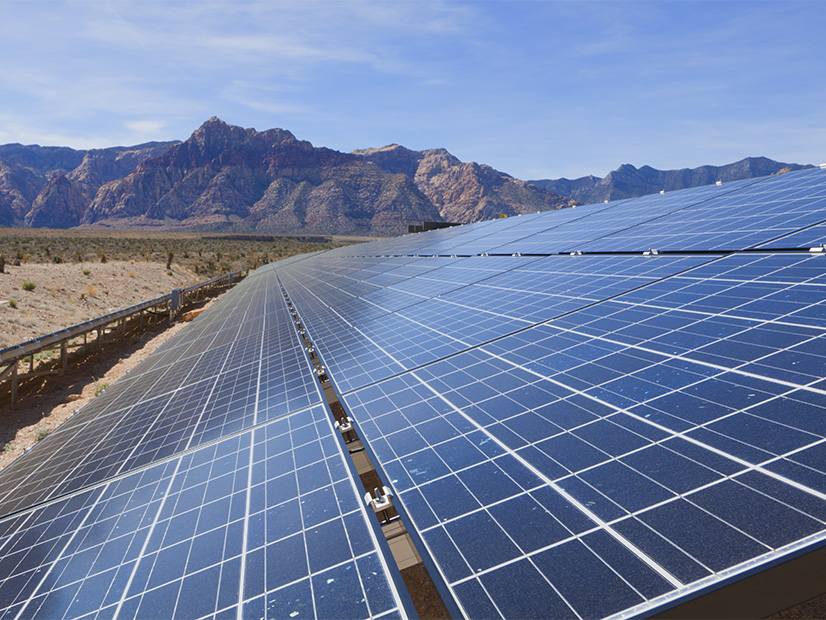The California Public Utilities Commission on Thursday ordered load-serving entities under its jurisdiction to procure an additional 4 GW of clean energy resources by 2027, adding to the record-setting 11.5 GW of procurements it ordered less than two years ago to bolster reliability and meet environmental goals.
“This additional procurement is necessary as electric demand is projected to further increase in the coming years and the accelerating impacts of climate change are creating new demands on our electric resource mix,” CPUC President Alice Reynolds said.
The additional procurement is part of the state’s massive buildup in renewable and zero-emitting resources as it tries to meet its 100% clean energy mandate by 2045 while avoiding repeats of the energy emergencies it experienced during the past three summers, including the rolling blackouts of August 2020. (See Calif. Must Triple Capacity to Reach 100% Clean Energy.)
The proposed decision adopted Thursday includes electricity resource portfolios for CAISO to use in its 2023/24 transmission planning process. The ISO updates its 10-year transmission plan annually.
The CPUC’s base-case portfolio anticipates the state will need 69 GW of new resources by 2033 and another 16 GW of new resources by 2035 to meet its environmental goals while maintaining reliability.
The additional 85 GW would be “on top of the existing resource mix on the electric grid of approximately 75 GW. This is more than a doubling of nameplate capacity on the system within 12 years,” the decision by Administrative Law Judge Julie Fitch says.
The base-case scenario includes 39 GW of solar and 28 GW of battery storage by 2035. It projects adding 3,900 MW of in-state wind, 4,800 MW of out-of-state wind and 4,700 MW of offshore wind in Northern and Central California.
The decision also recommends that CAISO study a 75 GW sensitivity portfolio that would add 13.4 GW of offshore wind. The portfolio “is designed to refine and update transmission capability and upgrade assumptions relevant to offshore wind resources,” it says.
In June 2021, the CPUC ordered load-serving entities — including Pacific Gas and Electric, Southern California Edison and San Diego Gas & Electric — to procure 11.5 GW of new clean-energy resources by 2026. It was the largest single procurement order in state history and followed a series of smaller procurement orders that began in 2019 and increased after the 2020 blackouts. (See CPUC Orders Additional 11.5 GW but No Gas.)
“This additional procurement for 2026 and 2027 is required for several reasons … [including] updated load forecasting from the California Energy Commission that suggests that electricity demand is increasing and will continue to increase compared to when [the 11.5 GW was ordered],” Fitch wrote in Thursday’s order.
She also cited the “increasing and accelerating impacts of climate change,” the “likelihood of some additional fossil-fueled generation resource retirements that were not anticipated at the time” and the “likelihood that some delays beyond 2026 in the procurement of long lead-time resources required by [the June 2021 decision] will be necessary.”
The latest decision postponed the procurement of long lead-time resources such as geothermal and long-duration storage from 2026 to 2028.
A number of parties to the most-recent proceeding expressed concerns that ordering another 4 GW could undermine the CPUC’s efforts to develop a “programmatic” approach to resource planning and keep the CPUC “stuck in a cycle of ad hoc, interim procurement orders,” the decision noted.
“A programmatic approach means moving beyond the CPUC’s current energy resource procurement order-by-order approach and setting rolling, ongoing requirements for LSEs [load serving entities] to meet,” the CPUC said in a fact sheet on the effort, called the Reliable and Clean Power Procurement Program.
The CPUC said it had to address reliability concerns before that program is ready.
“As much as we would like to agree … that we should focus on development of a programmatic approach to procurement, we also are convinced that we cannot wait for that larger process to be complete before ordering additional procurement,” the proposed decision said. “In 2022, the electric system came very close to running out of resources, and it actually did run out in 2020. The system is much closer to a supply and demand balance than is comfortable for reliability purposes.”
Tight supply and high prices in summer, “coupled with the lengthy lead time needed for the development of new resources, persuade us that we need to order new procurement now so that the LSEs can have sufficient time to contract for and develop the resources in a timely and cost-effective fashion.”


